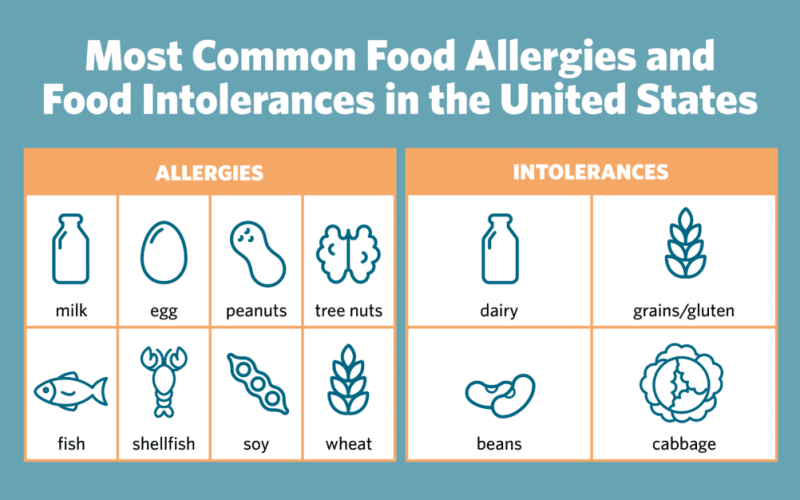A lot of people use the terms food allergy, and food intolerance interchangeably without actually know which is which or the difference between both terms.
It is good to understand what sets food allergies apart from food intolerances, mostly because these two medical conditions are known to have symptoms that potentially overlap (e.g., diarrhea, cramps, upset stomach, headache, and skin rash.
Below are a few facts to help you tell the difference between food allergy and food intolerance easily.
Allergy
Food allergy (also known as food hypersensitivity) has to do with an inappropriate reaction of the immune system to a seemingly harmless and non-pathogenic substance.
In this case, the human body reacts to the substance as though it were fighting a microorganism producing diseases. On first exposure to the food causing the reaction, the body’s immune system naturally produces antibodies known as immunoglobin E (IgE), which are often specific to the allergen.
With each subsequent exposure, the allergen will automatically bind to the IgE antibodies, which will trigger the immune system to initiate a more aggressive and rapid response.
This reaction is so intense that it can produce oral inflammation, cramps, canker sores, hives, nausea, diarrhea, gas, and sometimes may lead to respiratory distress.
Symptoms can show up immediately after you eat or could even take many hours to appear. These symptoms may also range from mild to severe.
So far, the most severe reaction associated with a food allergy is anaphylactic shock, and it affects the entire body, with symptoms often showing up within one hour after contact. Symptoms here include difficulty breathing, wheezing, swelling of the tongue and throat, fainting, and vomiting.
Anaphylaxis may be deadly and will always require immediate medical attention. Individuals with known allergies should always have an auto-injector of epinephrine handy. It is a medicine that will help to counteract the reaction in case of exposure to the food.
Food allergies are known to affect as many as 5-6% of children and up to 3-4% of adults in the Western world. Allergies are more likely to run in families and are quite common in young kids than they are in teenagers and adults.
This is likely because some children will outgrow their food allergies as they grow older. Allergies to milk, eggs, wheat, peanuts, and soy cause the most problems in kids, while adults most often deal with allergies to tree nuts, peanuts, shellfish, and fish.
Food Intolerance
In contrast to what we have discussed above (food allergy), food intolerance has absolutely nothing to do with the body’s immune system.
What intolerance can best be described as is an adverse reaction to a specific food, likely to start from the gastrointestinal system, often caused by an inability or a limited ability to digest or absorb specific foods or their components.
Symptoms of food intolerance usually start about half an hour after contact with foods or drinks, but some times they may not appear for up to 2 days (48 hours).
Symptoms of food intolerance include bloating, nausea, diarrhea, and abdominal pain. Two very common examples of food intolerance are:
Lactose Intolerance
As one of the world’s most famous examples of food intolerance, up to 70% of the earth’s population is unable to consume any dairy products or milk without getting a stomach upset.
Typically, the human body is able to produce the enzyme called lactase, which helps to digest the sugar that is found in milk (lactose).
Nevertheless, people who are lactose intolerant are unable to produce a sufficient amount of lactase, and, therefore, there is a lack of adequate digestion of milk-containing foods.
Undigested lactose will linger in the intestine and then ferments and cause bloating, abdominal pain, diarrhea, and flatulence.
Non-Celiac Gluten Intolerance
Although, individuals who have celiac disease must abide strictly by a gluten-free diet to avoid damage to their intestines.
Non-celiac individuals have found that staying away from gluten improves the gastrointestinal symptoms they experience, hence the fast-growing fame of gluten-free foods.
Regardless of limited scientific literature to back up its existence, this “non-celiac gluten intolerance,” also known as “wheat intolerance,” is assumed to be quite common.
One double-blind, randomized, and placebo-controlled trial revealed that patients reported gluten-induced symptoms of abdominal pain, bloating, dissatisfaction with stool consistency, and tiredness.
Also, there is no proof that non-celiac gluten intolerance leads to any form of damage to the small intestine.
| Food allergy | Food intolerance | |
|---|---|---|
| Activates immune system | Yes | No |
| Exposure required to trigger symptoms | Tiny portion | Normal sized portion |
| Reaction time frame after exposure | Immediately or 1 to 2 hrs | 45 mins to 2 days |
| Treatment | Food avoidance, medicine | Food limitation, complete avoidance |
On the 16th of February, 2011, Health Canada reportedly published amendments to the country’s Food Allergen Labeling Regulations. The present guidelines make it compulsory that most foods that come pre-packaged carry a label listing all the ingredients in decreasing order of proportion.









